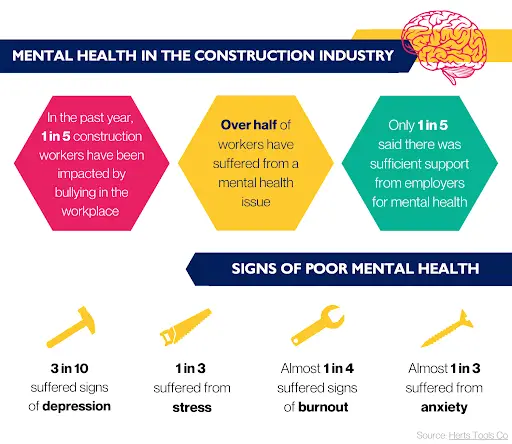Are you tired of feeling overwhelmed by anxiety in the moment? Look no further, because this article is here to provide you with effective strategies for reducing those anxious feelings. From deep breathing exercises like the 4-7-8 technique to the grounding 5-4-3-2-1 coping technique, there are plenty of techniques for you to try. Not only that, but you’ll also discover the power of visualizing humorous moments, finding temporary distractions, and even taking a cold shower. By incorporating these strategies into your life and making long-term changes, such as identifying triggers and prioritizing self-care, you can successfully reduce your overall anxiety levels. Say goodbye to anxiety and hello to a calmer, more peaceful state of mind.
Recognizing and Naming Anxiety
anxiety can manifest itself differently in each individual, but it is important to learn how to recognize and name the signs and symptoms associated with it. By understanding the physical and emotional cues of anxiety, you can begin to address and manage these feelings effectively. Physical signs of anxiety may include a rapid heartbeat, shortness of breath, sweating, and tense muscles. On the other hand, emotional signs may involve excessive worry, fear, restlessness, irritability, and difficulty concentrating. By acknowledging and labeling these feelings as anxiety, you take the first step towards addressing and managing them.
Recognizing and naming your anxiety has many benefits. Firstly, it allows you to gain a sense of control over your emotions. By understanding that what you are experiencing is anxiety, you can distinguish it from other emotions and thoughts. This recognition enables you to adopt specific strategies to manage your anxiety effectively. Additionally, naming anxiety provides validation for your experiences. It helps reduce feelings of isolation by acknowledging that anxiety is a common and valid emotional response to certain situations. By recognizing that you are not alone in your experiences, you can seek support from others who may have similar struggles.
Steps for Naming Your Anxiety
To name your anxiety, begin by acknowledging and accepting the feelings you are experiencing. Take a moment to tune in to your body and emotions. Pay attention to any sensations, thoughts, or worries that come up. Once you have identified that you are feeling anxious, try to put it into words. Describe your anxiety as accurately as possible. For example, you might say, “I am feeling anxious about my upcoming presentation at work because I am worried about making mistakes.” By articulating your anxiety, you are giving it a name and making it more tangible. This step can help you to better understand and respond to your anxious thoughts and feelings.
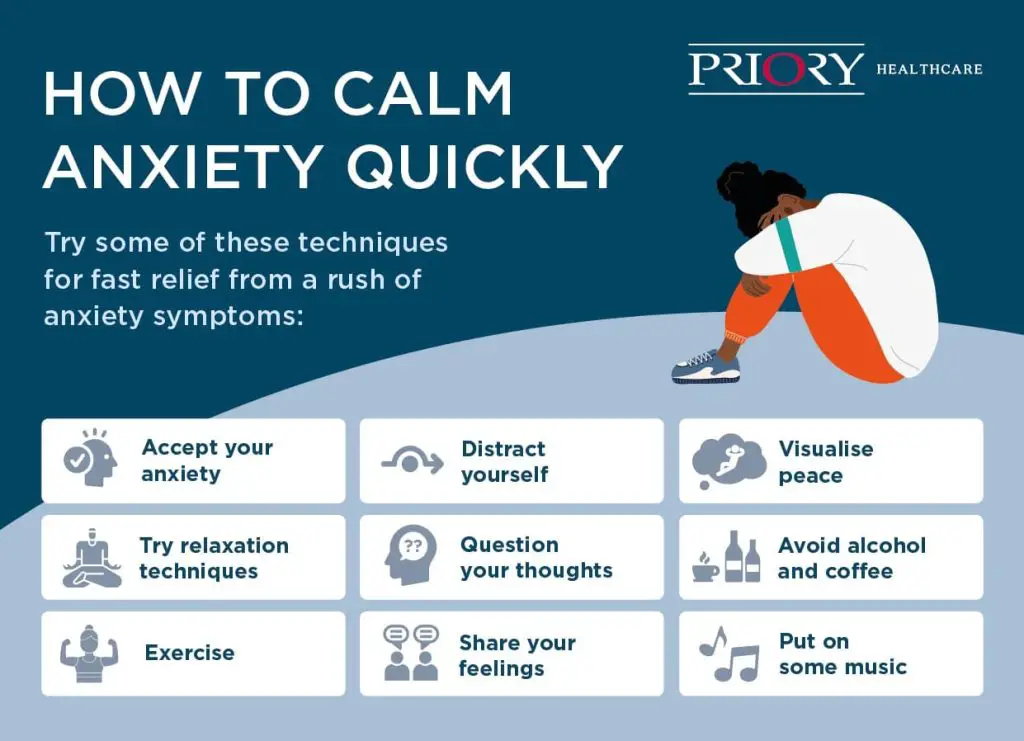
This image is property of www.priorygroup.com.
Breathing Techniques for Anxiety Reduction
When anxiety strikes, deep breathing exercises can be a helpful tool to calm your mind and body. Deep breathing is a simple yet effective technique that can be done anywhere and at any time. One popular deep breathing technique is the 4-7-8 breathing technique. To practice this technique, start by finding a comfortable position and take a deep breath in through your nose for a count of four. Hold your breath for a count of seven, and then exhale slowly through your mouth for a count of eight. Repeat this cycle several times, focusing on the sensation of your breath and the calming effect it has on your body.
Deep breathing is beneficial for anxiety reduction as it activates the body’s relaxation response. When we experience anxiety, our body’s stress response is triggered, leading to shallow and rapid breathing. Deep breathing helps counteract this by slowing down our breath and promoting relaxation. It can lower heart rate and blood pressure, reduce muscle tension, and provide a sense of calm. By incorporating deep breathing exercises into your daily routine, you can develop a valuable tool for managing anxiety symptoms.
Grounding Techniques: The 5-4-3-2-1 Coping Strategy
The 5-4-3-2-1 coping strategy is a grounding technique that can be used to reduce anxiety and bring yourself back to the present moment. This technique involves engaging your five senses and focusing on sensory details in your surroundings. Start by identifying five things you can see in your environment. Pay close attention to the colors, shapes, and textures of these objects. Next, shift your focus to four things you can touch. Notice the temperature, texture, and weight of these objects. Then, identify three things you can hear, whether it’s the sound of birds chirping or the hum of traffic outside. After that, think about two things you can smell, such as the scent of freshly brewed coffee or the fragrance of flowers. Finally, focus on one thing you can taste, whether it’s a mint or a sip of water.
Implementing the 5-4-3-2-1 coping strategy can help reduce anxiety by diverting your attention away from anxious thoughts and into the present moment. By engaging your senses, you anchor yourself to the present reality, breaking free from the spiral of anxious thoughts. This technique can provide a sense of grounding and calm, as it shifts your focus to the tangible and immediate sensory experiences in your surroundings. By practicing this technique regularly, you can train your mind to stay present and reduce anxiety symptoms.

This image is property of www.nicabm.com.
‘File it’ Technique to Manage Anxious Thoughts
The ‘File It’ technique is a visualization exercise that can help you manage anxious thoughts and worries. To practice this technique, imagine your worries as individual files in a filing cabinet. Close your eyes and visualize each worry as a separate file folder. Take a moment to vividly imagine the details of each file folder, including the label, color, and texture. Then, mentally place each worry into its respective file folder and imagine closing the cabinet drawer. By mentally organizing and categorizing your worries, you create a visual representation of consciously putting them aside.
The ‘File It’ technique offers several benefits for managing anxious thoughts. Firstly, it allows you to acknowledge and validate your worries without letting them consume your mind. By visualizing your worries as separate files, you create a clear separation between your thoughts and your identity. This technique helps you recognize that your worries do not define you and that they can be managed. Secondly, the ‘File It’ technique promotes a sense of control over your thoughts. By actively sorting and organizing your worries, you take charge of your mind and reclaim the power over your anxious thoughts. Finally, this technique helps in creating mental space for positive and productive thinking. By consciously putting your worries aside, you make room for more constructive and positive thoughts to emerge.
Role of Exercise in Reducing Anxiety
Exercise is not only beneficial for physical health but also plays a significant role in reducing anxiety. Engaging in regular physical activity can help manage anxiety symptoms by increasing the production of endorphins, which are natural mood elevators. Exercise can also act as a distraction from anxious thoughts and provide a sense of accomplishment, boosting self-confidence. Different types of exercises can be effective in managing anxiety, including aerobic exercises like running, cycling, or swimming that elevate heart rate, as well as low-impact exercises like yoga or tai chi that focus on mindfulness and relaxation.
The benefits of exercise in reducing anxiety are multifaceted. Firstly, exercise releases endorphins, known as the “feel-good” hormones that can improve mood and reduce stress. This natural chemical response can counteract the effects of anxiety and promote a sense of well-being. Regular exercise can also improve sleep quality, which is often disrupted by anxiety. Exercise helps to regulate the sleep-wake cycle and enables better rest, leading to reduced anxiety levels. Additionally, exercise provides an outlet for pent-up energy and tension, helping to alleviate physical symptoms of anxiety such as muscle tension and restlessness. However, it is essential to practice caution when engaging in exercise, starting gradually and listening to your body’s limits.
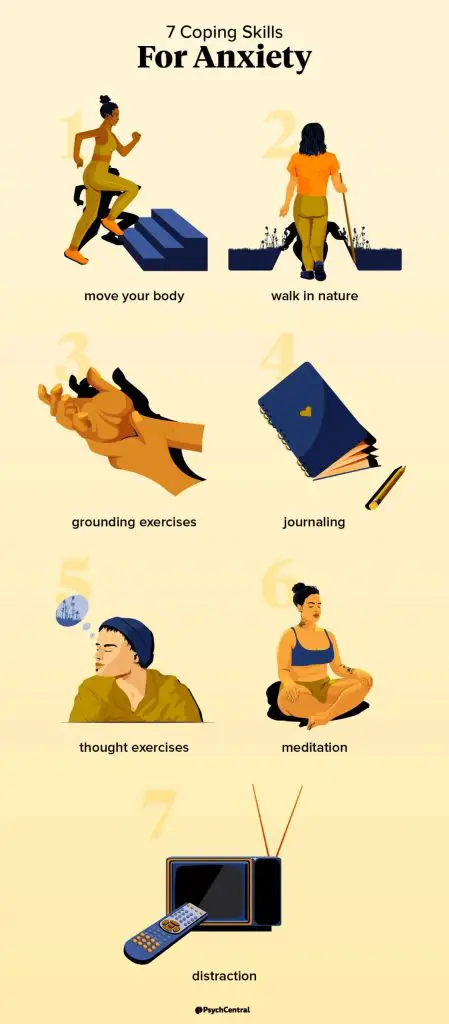
This image is property of i0.wp.com.
Use of Positive Visual Imagery
Positive visual imagery can be a powerful tool for reducing anxiety by shifting your focus to more pleasant and soothing thoughts. One technique involves visualizing humorous moments or memories. Close your eyes and recall a funny incident or a joyful memory. Try to immerse yourself in the details, imagining the sights, sounds, and emotions associated with that moment. It could be a funny family gathering, a comical incident with friends, or a silly memory from childhood. By actively engaging in positive mental imagery, you create a mental escape from anxious thoughts and replace them with positive emotions.
The impact of positive visual imagery on anxiety is significant. By focusing on humorous moments or memories, you activate the brain’s reward centers, triggering the release of dopamine, which is associated with pleasure and happiness. This shift in focus helps to interrupt the cycle of negative thinking and anxiety. Additionally, positive imagery promotes relaxation and reduces physiological symptoms of anxiety, such as increased heart rate and muscle tension. By regularly incorporating positive visual imagery into your routine, you can cultivate a more positive mindset and reduce anxiety levels over time.
Temporary Distractions to Shift Focus from Anxiety
Sometimes, the best way to manage anxiety is to temporarily redirect your attention to something unrelated. Distraction techniques can be particularly effective in shifting your focus away from anxious thoughts and redirecting it towards more positive or enjoyable activities. Engaging in hobbies or activities that you enjoy can provide a temporary escape from anxiety. Whether it’s reading a book, painting, gardening, listening to music, or engaging in any other hobby, these activities divert your attention and provide a sense of pleasure and relaxation.
The benefits of these temporary distractions are manifold. Firstly, they give your mind a break from constant worry and anxious thoughts. By immersing yourself in an activity you enjoy, you can experience a sense of flow, where you are fully engaged and absorbed in the present moment. This can provide a much-needed respite from anxiety and promote a sense of calm. Secondly, engaging in pleasurable activities releases endorphins, which act as natural painkillers and mood elevators. This can aid in reducing anxiety symptoms and cultivating positive emotions. Finally, distractions provide an opportunity for positive reinforcement and a boost in self-esteem. By engaging in activities you enjoy, you can experience a sense of accomplishment and satisfaction, which can counteract the negative effects of anxiety.
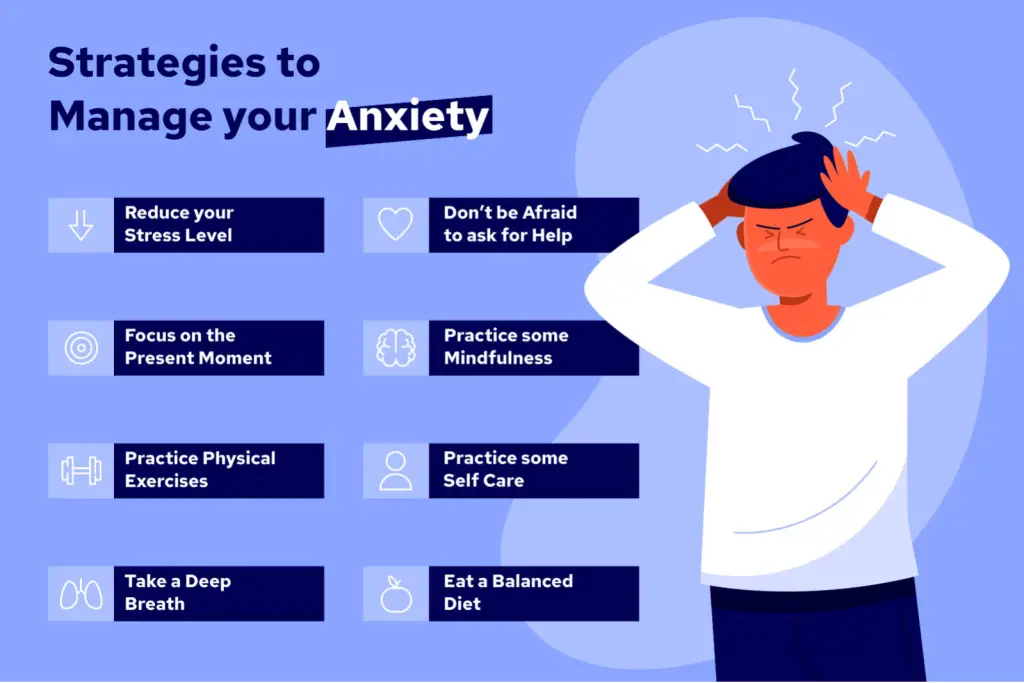
This image is property of www.calmclinic.com.
Physical Techniques: Cold Showers and Face Immersion
Physical techniques such as cold showers and face immersion can be used to reduce anxiety by triggering a physiological response that promotes relaxation. Cold showers involve taking a shower with water at a cooler temperature than usual, while face immersion refers to briefly plunging your face into cold water. Both of these techniques stimulate the body’s “dive response,” which slows down the heart rate and activates the parasympathetic nervous system.
The science behind cold showers and face immersion lies in the body’s response to cold temperatures. When exposed to cold water, the body increases circulation to vital organs, reducing blood flow to the extremities. This response leads to a decrease in heart rate and blood pressure, resulting in a sense of calm and relaxation. Cold showers and face immersion can be particularly helpful during moments of heightened anxiety or panic, as they provide an immediate physical sensation that can interrupt anxious thoughts.
To implement these techniques, start by gradually incorporating cold showers or face immersion into your routine. Begin by adjusting the water temperature to a slightly cooler level and gradually decrease it as you become more comfortable. While taking a shower, focus on the sensation of the cold water on your body or immerse your face in a basin or sink filled with cold water for a few seconds. However, it is important to note that cold showers and face immersion may not be suitable for everyone, especially those with certain medical conditions, so it is important to consult with a healthcare professional before attempting these techniques.
Long-term Strategies for Anxiety Reduction
While there are various techniques to manage anxiety in the moment, it is equally important to adopt long-term strategies that can help reduce overall anxiety levels. Identifying triggers of anxiety is a crucial step in managing and reducing anxiety. Take note of situations, people, or thoughts that consistently lead to anxious feelings and work on addressing them. This could involve seeking therapy, practicing self-reflection and journaling, or making lifestyle changes to avoid triggers.
Incorporating self-care routines into your daily life is another effective long-term strategy for anxiety management. This can involve activities such as practicing mindfulness or meditation, engaging in regular exercise, prioritizing restful sleep, maintaining a balanced diet, and nurturing your social connections. Self-care routines help promote overall well-being and create a foundation of resilience against anxiety.
Adopting healthy habits can significantly contribute to lower anxiety levels. This includes managing stress through techniques like time management, setting boundaries, and practicing relaxation exercises regularly. It also involves cultivating positive thinking patterns, challenging negative thoughts, and reframing your perspective. Embracing a growth mindset, seeking support from loved ones, and practicing self-compassion are additional strategies for managing anxiety in the long term.
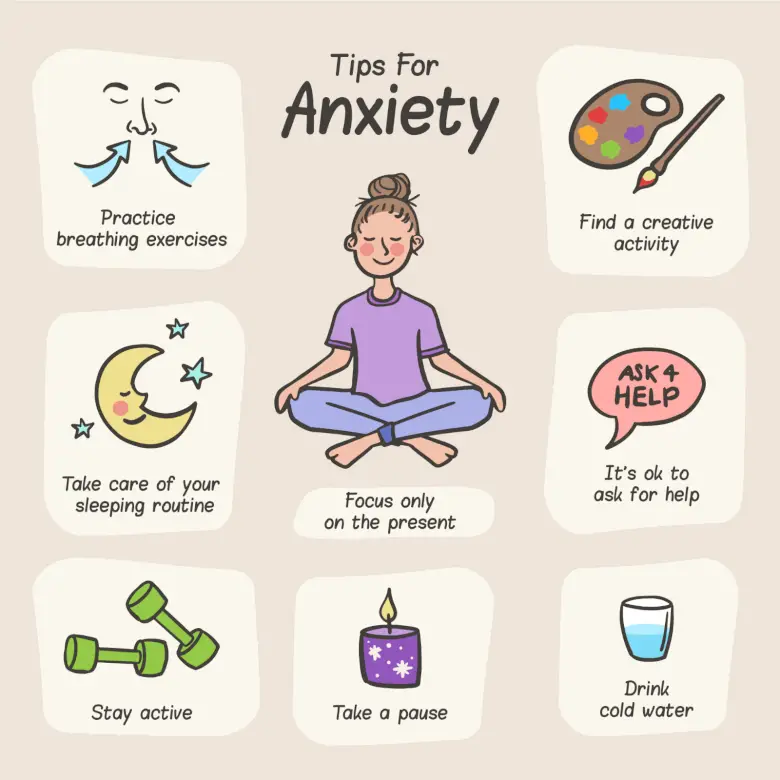
This image is property of www.calmclinic.com.
Mindfulness and Meditation as Anxiety Reduction Techniques
Mindfulness and meditation are powerful techniques that can significantly reduce anxiety by promoting a sense of presence and calm. Mindfulness involves intentionally paying attention to the present moment without judgment. It can be practiced through various exercises, such as focusing on your breath, observing sensations in your body, or engaging in mindful walking. Meditation, on the other hand, involves training the mind to achieve a state of focus, calm, and relaxation. There are different types of meditation techniques, including loving-kindness meditation, body scan meditation, and transcendental meditation.
Both mindfulness and meditation have numerous benefits for anxiety reduction. They help cultivate a non-reactive and non-judgmental attitude towards anxious thoughts and emotions, allowing you to observe them without being consumed by them. These practices promote a sense of calm and relaxation by activating the parasympathetic nervous system, which is responsible for the body’s rest and digest response. Mindfulness and meditation also improve emotional regulation, reducing the intensity and frequency of anxious feelings. By regularly incorporating these practices into your routine, you can develop resilience against anxiety and enhance your overall well-being.
In conclusion, recognizing and naming anxiety, practicing breathing techniques, engaging in grounding strategies, using visualization techniques, incorporating exercise, embracing positive visual imagery, utilizing temporary distractions, implementing physical techniques, adopting long-term strategies, and practicing mindfulness and meditation are all effective strategies for reducing anxiety. By understanding and implementing these techniques, you can take control of your anxiety and improve your overall quality of life. Remember, managing anxiety is a journey, and it may require a combination of different approaches to find what works best for you. With time, practice, and persistence, you can successfully reduce anxiety and cultivate a greater sense of peace and well-being.

